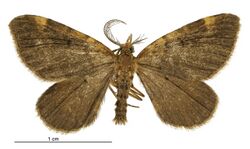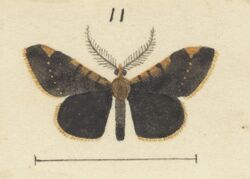Biology:Asaphodes chlorocapna
| Asaphodes chlorocapna | |
|---|---|

| |
| Male | |
| Scientific classification | |
| Domain: | Eukaryota |
| Kingdom: | Animalia |
| Phylum: | Arthropoda |
| Class: | Insecta |
| Order: | Lepidoptera |
| Family: | Geometridae |
| Genus: | Asaphodes |
| Species: | A. chlorocapna
|
| Binomial name | |
| Asaphodes chlorocapna (Meyrick, 1925)[1]
| |
| Synonyms[2] | |
| |
Asaphodes chlorocapna is a species of moth in the family Geometridae. This species is endemic to New Zealand and can only be found in the Chatham Islands. The larvae of this species consume the leaves of Muehlenbeckia plants. Adults are on the wing in January. This species is classified as "At Risk, Relict'" by the Department of Conservation.
Taxonomy
This species was first described by Edward Meyrick in 1925 as Xanthorhoe chlorocapna using a specimen collected by Stewart Lindsay at Mangere Island, in the Chatham Islands.[2][3] George Hudson discussed and illustrated the species in 1928 using the name Xanthorhoe chlorocapna.[4] In 1987 R. C. Craw placed this species within the genus Asaphodes.[5] The holotype specimen is held at the Canterbury Museum.[2]
Description
Meyrick described the species as follows:
♂︎ 24-26 mm. Head, palpi, thorax pale greyish-ochreous irrorated blackish. Antennal pectinations ten ; forewings with termen slightly bowed, rather oblique ; light smoky-grey suffusedly irrorated dark fuscous ; costal area from base to 4⁄5 rather broadly suffused pale greyish-ochreous, with groups of two antemedian, and three postmedian dark fuscous shades crossing it, but becoming obsolete downwards ; discal spot small, transverse, dark fuscous ; cilia whitish, basal half dark grey. Hind wings dark grey ; cilia whitish, basal third grey.[3]
Distribution
This species is endemic to New Zealand.[1][6] It can only be found in the Chatham Islands where it can be found on Mangere Island, Pitt Island and Rangatira Island.[7]
Biology and life cycle
Adult moths are on the wing in January.[4]
Host plants and habitat
The larvae of this moth consume the fallen leaves of Muehlenbeckia species.[7]
Conservation status
This moth is classified under the New Zealand Threat Classification system as being "At Risk, Relict".[8]
References
- ↑ 1.0 1.1 "Asaphodes chlorocapna (Meyrick, 1925)". Landcare Research New Zealand Ltd. http://www.nzor.org.nz/names/48a01ba3-45dc-425b-9b56-3d52d851abbc.
- ↑ 2.0 2.1 2.2 , pp. 172, Wikidata Q45083134
- ↑ 3.0 3.1 , Wikidata Q110706860
- ↑ 4.0 4.1 , pp. 114, Wikidata Q58593286
- ↑ , Wikidata Q54670161
- ↑ , p. 459, Wikidata Q45922947
- ↑ 7.0 7.1 Patrick, Brian; Dugdale, John S. (2000). Conservation status of the New Zealand lepidoptera. Wellington, N.Z.: Department of Conservation, New Zealand. pp. 19. ISBN 978-0478218671. OCLC 154670803. https://www.doc.govt.nz/documents/science-and-technical/Sfc136.pdf.
- ↑ Hoare, R.J.B.; Dugdale, J.S.; Edwards, E.D.; Gibbs, G.W.; Patrick, B.H.; Hitchmough, R.A.; Rolfe, J.R. (2017). Conservation status of New Zealand butterflies and moths (Lepidoptera), 2015. Wellington, New Zealand: New Zealand Department of Conservation. p. 7. ISBN 9781988514383. http://www.doc.govt.nz/Documents/science-and-technical/nztcs20entire.pdf.
Wikidata ☰ Q41796439 entry
 |



